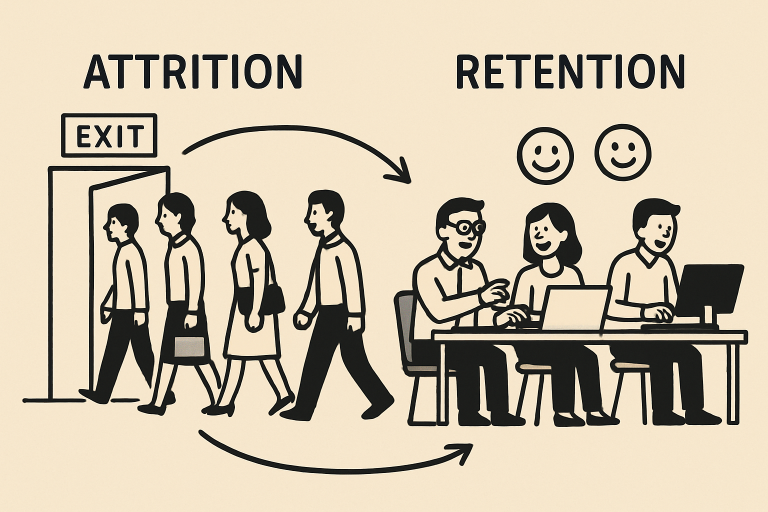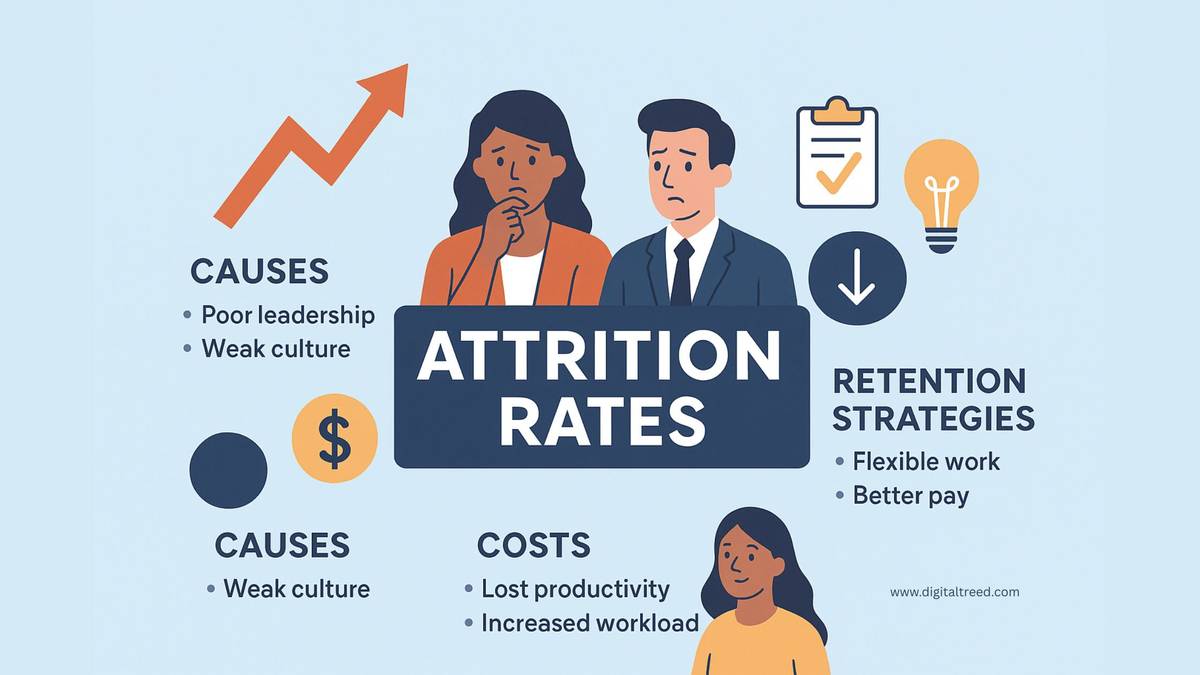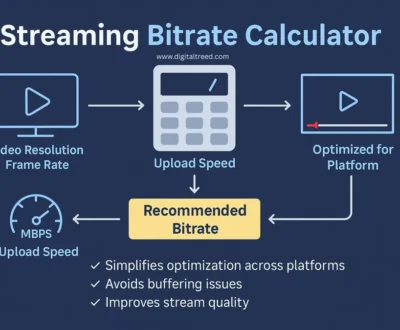Key Takeaways
- Attrition rates reveal valuable insights into employee satisfaction and organizational health.
- Understanding the causes can help reduce turnover and associated costs.
- Implementing strong retention strategies can foster a more committed and engaged workforce.
- Data and research-driven approaches have proven effective in lowering attrition rates.
- Businesses that address attrition proactively tend to see long-term gains in productivity and culture.
Table of Contents
- Why Attrition Rates Matter in Today’s Workplaces
- What Drives Employee Attrition?
- The Hidden Costs of High Attrition
- How to Calculate Attrition Rate: A Brief Guide
- Top Strategies to Curb Attrition
- Real Examples of Successful Attrition Management
- How Remote Work Is Changing Attrition Trends
- FAQs About Attrition and Retention
- Conclusion: Staying Ahead in a Changing Workforce
Why Attrition Rates Matter in Today’s Workplaces
Organizations of all sizes recognize that their ability to attract, engage, and retain talent profoundly influences the future of their workplace. One of the most telling indicators of organizational health is the attrition rate, which measures the percentage of employees who leave a company over a given period. Understanding this metric allows leaders to identify patterns and root causes of employee turnover, which, left unchecked, can undermine workplace culture and productivity. With the average turnover rate in the U.S. reaching nearly 19% annually, according to the Society for Human Resource Management, there is heightened focus on how rising attrition rates can erode both morale and the bottom line. Analyzing these trends is not just a task for the HR department—it has become a strategic priority. Proactive steps to monitor and address attrition signal a commitment to creating a more stable and positive environment for everyone.
What Drives Employee Attrition?
High employee turnover rarely happens without warning. Multiple factors fuel attrition: poor leadership, lack of advancement, misaligned values, inadequate compensation, and weak workplace culture. Research from corporate and HR experts highlights that insufficient recognition and weak communication are often underestimated drivers of attrition. These less obvious factors contribute greatly to a sense of stagnation or frustration among team members. By dedicating resources to regular feedback, recognition, and career development programs, organizations can directly influence retention rates in a positive direction. This approach helps employees feel seen and valued, deepening their sense of loyalty and belonging.
The Hidden Costs of High Attrition
While the cost of hiring a replacement is significant, the broader cost of high attrition extends far beyond recruiting fees. Turnover drains resources through lost productivity, disrupted team dynamics, diminished institutional knowledge, and increased workloads for remaining staff. Multiple studies estimate that replacing a single employee may cost between one-third and twice their annual salary, depending on their seniority and skillset. This financial impact can add up quickly, threatening an organization’s ability to innovate and compete. The U.S. Bureau of Labor Statistics consistently tracks these trends, reinforcing the need for vigilant workforce management.
How to Calculate Attrition Rate: A Brief Guide
- Choose a specific timeframe, such as monthly, quarterly, or yearly.
- Divide the number of employees who left during the period by the average number of employees.
- Multiply by 100 to convert the number into a percentage.
Regular calculation and analysis of attrition rates gives leadership a clear, actionable metric to monitor. These insights enable prompt intervention to mitigate emerging issues before they escalate.
Top Strategies to Curb Attrition
- Design comprehensive onboarding programs to set new hires up for success early.
- Offer salaries and benefits that are competitive within the market and transparent to employees.
- Develop clear career paths and upskilling opportunities to support professional growth.
- Champion open communication and regularly involve staff in decision-making where possible.
- Implement ongoing feedback and recognition systems to understand employee needs and satisfaction.
These strategies are proven to foster greater satisfaction, reduce turnover, and support a strong, stable culture. A transparent and supportive environment remains among the most effective tools for long-term retention.

Real Examples of Successful Attrition Management
Several organizations stand out for turning around high attrition with targeted strategies. For instance, companies that offered flexible scheduling, personalized professional development plans, and continuous engagement surveys saw their attrition rates fall significantly in under two years. Google, for example, has famously used data-driven “people analytics” to detect workplace trends and adjust policies accordingly, serving as a model for evidence-based HR initiatives. The common thread among top performers is the willingness to adapt and listen closely to their workforce.
How Remote Work Is Changing Attrition Trends
The rapid adoption of remote and hybrid organizational models has already affected attrition rates across industries. Flexibility—once a competitive advantage—has now become an expectation for many employees. Research published by Gallup reports that remote-capable workers with flexibility options report greater happiness and are less likely to leave their jobs compared to those without choice. However, remote work also brings fresh challenges: less direct engagement with colleagues and leadership can make employees feel less connected,
increasing the risk of disengagement or job-hopping. Successful organizations work proactively to keep remote workers engaged and supported, using technology and virtual touchpoints.
FAQs About Attrition and Retention
Quarterly reviews are recommended, with annual reviews as the minimum.
Yes, because the drivers behind voluntary and involuntary departures often differ, distinct reporting leads to better strategies and solutions.
Company culture is a major factor determining whether employees stay or go, as it shapes daily experiences and long-term outlooks.
Conclusion: Staying Ahead in a Changing Workforce
A data-driven approach to managing attrition and building strong retention practices pays substantial dividends. Companies that routinely survey their staff, analyze attrition data, and adjust policies to workforce needs are better equipped to face rapid changes in today’s labor market. Organizations that prioritize employee experience, embrace flexibility, and foster open communication are the ones most likely to thrive in the years ahead.
Aijaz Alam is a highly experienced digital marketing professional with over 10 years in the field. He is recognized as an author, trainer, and consultant, bringing a wealth of expertise to his work. Throughout his career, Aijaz has worked with companies such as Arena Animation and Sportsmatik.com. He previously operated a successful digital marketing website, Whatadigital.com, where he served an impressive roster of Fortune 250 companies. Currently, Aijaz is the proud founder and CEO of Digitaltreed.com.

About us and this blog
We are a digital marketing company with a focus on helping our customers achieve great results across several key areas.
Request a free quote
We offer professional SEO services that help websites increase their organic search score drastically in order to compete for the highest rankings even when it comes to highly competitive keywords.











Your work has genuinely made such 💯 a positive difference in my entire life
Your creativity never stops
Your posts 🔥 consistently deliver exactly what your audience needs most right now
Thanks for taking time to create content that actually makes a difference